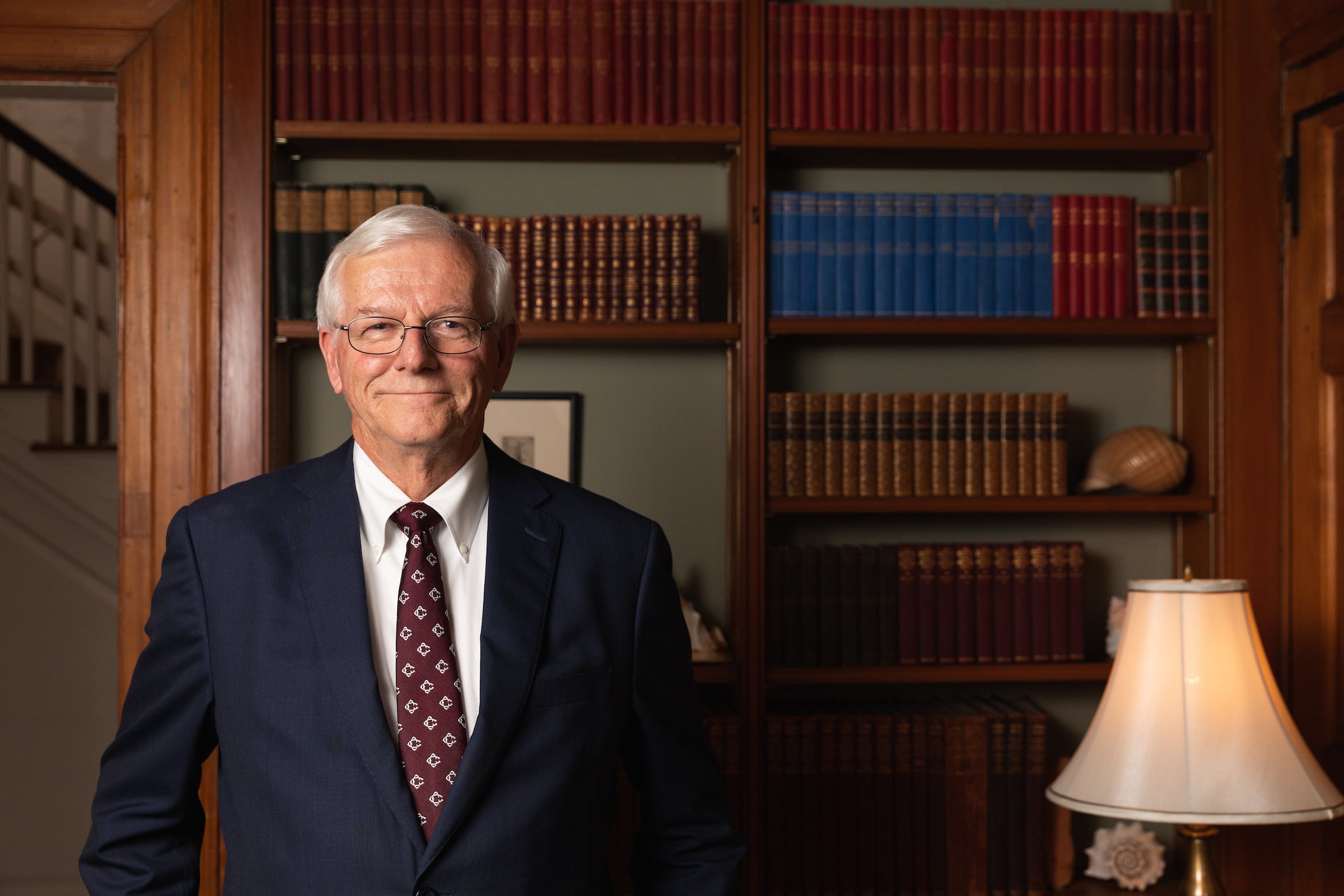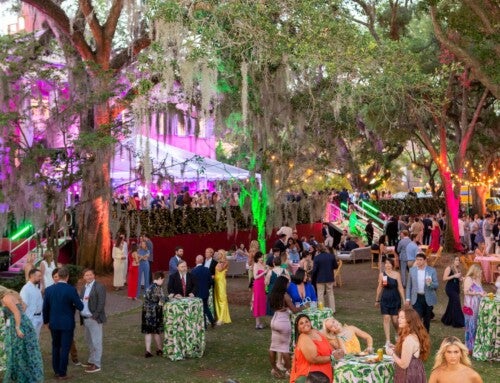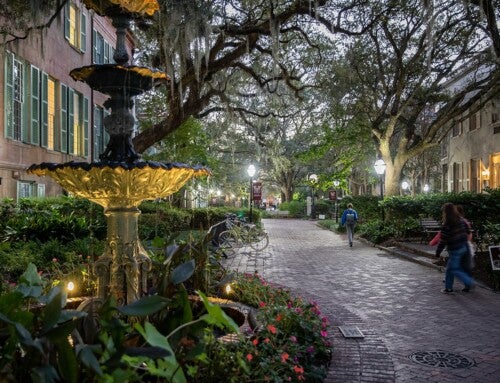Don’t let the soft voice fool you. Or the suit and tie, for that matter. What appears outwardly mild mannered, almost corporate in sound and dress, disguises something else entirely. This past summer, Stephen C. Osborne ’73, a longtime administrator and recently retired special adviser to the president’s office, became the interim president of the College – and, in the process, transformed himself from a Clark Kent into a Superman of sorts, better known to the campus community as President Oz.
For those who know Osborne well, this transformation was not altogether surprising. He didn’t need a telephone booth to don a cape and tights and thus become someone new. His superpowers have always been hiding in plain sight. He just needed a microphone and the bully pulpit of the president’s office for more people to hear and see him. Now squarely in the spotlight, Osborne and his passion for the College, which has always been evident, naturally command center stage.
And, while his reign has a timer set to it, serving in the interim role between retired President Glenn F. McConnell ’69 and newly elected president Andrew T. Hsu, Osborne has always been clear eyed about his role: that he never saw himself as simply a caretaker. If the Board of Trustees wanted someone to just keep the lights on for a few months, there were other people who could do that. Osborne did not believe that hitting “pause” would help his alma mater. No, he had ideas, and he wanted to use his time to enact a handful of initiatives that would keep the momentum of the last few years going.
Land of Oz
Every superhero has an origin story, and Florence, S.C., has a Smallville quality to it. Established in 1853 and named for the daughter of an early railroad executive, Florence was a railroad terminal in the Pee Dee region of the state. Over time, the city grew to be the largest in the area, with more than 22,000 residents during Osborne’s childhood in the 1950s and ’60s.
“Florence is a little more cosmopolitan than you may think,” Osborne says of his hometown. “We have a museum, a symphony and a college campus. It was a great place to grow up. It even gave me a leg up before heading off to college. I was one of a group of students selected to take college-level classes at the University of South Carolina – Florence [today’s Francis Marion University]. So, before I even started my freshman year, I had already taken English and two semesters of calculus. I laugh now, but because my score on the SAT exam hit a certain level – by just five points! – I skipped pre-calculus. That was pretty rough.”
While Osborne would spend much of his career known as a numbers guys (he was the chief financial officer and executive vice president of business affairs at the College for more than a decade), his true passion has always been literature and history.
“Even in high school, I loved F. Scott Fitzgerald and Ernest Hemingway,” recalls Osborne. “And that admiration for literature only increased when I came to the College of Charleston as an undergraduate.”
For him, the choice to attend the College was fairly straightforward. The money was right (clearly, he has always had a CFO’s mentality) and he knew the campus well. For years, he had been coming to visit his brother, Ron Osborne ’69, and would stay with him in his room in Craig Union (the College’s first residence hall).
“Ron played basketball and was the No. 1 tennis player for the Maroons [the College’s athletics mascot before the 1970 change to the Cougars],” says Osborne. “He would show me around campus and the city, take me to parties, and it was easy for me to imagine myself here.”
“Engaging with students has been the best part of this experience… This is an amazing place.” – Interim President Stephen C. Osborne ’73
When he arrived on campus in fall 1970, change was afoot. College President Ted Stern had finalized a deal with the state legislature for the College to become a public university, and the 1970–71 academic year represented the College’s first year as a state institution.
In many ways, Osborne’s experience represents the transition from the Old to the New – an exclusionary, elitist mindset giving way to the public, more broad-minded mission of today’s College. However, one stalwart straddles those eras: Randolph Hall.
“Yes, it’s hard to believe, but I took all of my first-year classes in Randolph Hall,” remembers Osborne with a smile. “And, at that time, College Way and Green Way were active streets. President Stern did a lot to create what we consider the historic core of campus today, from closing those two streets to car traffic, to acquiring historic houses where we would take classes, to constructing the Robert Scott Small Library my last year in school.”
To Osborne, the College was an intellectual playground. He loved the breadth of the liberal arts curriculum, which allowed him to study more thoroughly literature, history and language, while also pursuing his interests in political science.
“I have always respected and been interested in how power actually operates in society,” says Osborne. “And my professors were terrific at explaining and helping me understand the political system. Professor Bill Moore was certainly a highlight. It was his first teaching job, and he started my second year here. I took a number of his classes, and he was by far the most influential teacher I had. I also enjoyed Tom Palmer and Earl Kline, the chair of the department, who wore a blue seersucker suit. It’s funny some of the details you remember.”
Against a national backdrop of escalating tensions surrounding the conflict in Vietnam, Osborne enjoyed an almost idyllic existence. A self-described “keen sports fan” (he loves the Green Bay Packers and Detroit Tigers), Osborne was neighbors with several basketball players in Craig Union his freshman year. They mentioned to him that they needed a team manager, and Coach Alan LeForce offered to cover his room and board if he were interested.




“I was the team manager my second and third years of school,” says Osborne. “I was a jack of all trades: I kept up with the equipment and made sure everything was ready for practice. During scrimmages, I officiated and sometimes even played point guard – when only nine players were available because of injuries. On the road, I would keep the books and scores.”
During his last year at CofC, Osborne, and many of the basketball players, lived on the third floor of the Silcox Gymnasium (today’s Willard A. Silcox Physical Education and Health Center). His small corner room overlooked George Street.
“It was great,” laughs Osborne. “Yes, my space was pretty tiny. It had just enough room for a bed, dresser and sink. Today, faculty from the Department of Health and Human Performance occupy that space. At night, we would go down into the old Silcox gym and use it as our playroom. There were trampolines, and the stage in there had a badminton set up. Gus Gustafson ’75 [the second leading scorer in Cougars’ men’s basketball history] and I would play. Of course, he had a slight height advantage.”
Off to See the Wizard
President Osborne makes his way across the Cistern Yard. A guide from the Charleston 40, leading a tour of roughly 30 prospective students, calls out, “Hey, President Oz.” He smiles and waves to her as he heads to his next meeting. She laughs, saying, “That’s our president,” and returns to her points about the Cistern Yard serving as one of the most beautiful graduation locations in the country.
During the fall semester, Osborne made a commitment to engage with as many students as he possibly could.
“During my student days, I knew President Stern well,” he says, “and I hope some of these students may say the same of me. It makes a difference with how you connect to a school.”
In a short time, he has done a lot to put the students first and to make those connections: playing pool with them in the Stern Student Center (word of advice: don’t play with someone who owns a cue stick and who made it a hobby to beat Citadel cadets during his heyday in the ’70s), hosting numerous student groups at 6 Glebe Street (the President’s House), holding open office hours for students and speaking to various student groups throughout the semester.
“Engaging with students has been the best part of this experience,” admits Osborne. “I have always known that we – our faculty, our student affairs team and our staff – do a tremendous job with our students. But by stepping away from behind the desk and interacting one on one with our students, I am constantly reminded how bright, how energetic, they are. This is an amazing place.”
And that is why from Day One of his presidency, he outlined his four priorities, which focus on the campus experience, the academic experience, philanthropy and planning for the College’s 250th anniversary celebration in 2020.
Since assuming the presidency, he has worked in overdrive to support the student experience, especially in regards to internships and study-abroad opportunities, to increase diversity recruitment (the College attracted one of its largest number of students of color in this past fall’s freshman class), to bolster in-state recruitment efforts through the expanded Cougar Advantage program (a pilot initiative that accepts the top 10 percent of graduating seniors from 15 S.C. counties and now incorporates a study-abroad component for Pell-eligible students) and to help launch Chucktown Sound, the school’s reinvented pep band.
In the academic realm, Osborne again has shunned the caretaker act. He believes in the critical role the College’s graduate programs can play in the region. To that end, he is putting the Graduate School on more solid financial footing and has tabbed Godfrey Gibbison, dean of the School of Professional Studies, to serve in an interim leadership role to strengthen its offerings. Osborne has also partnered with Provost Brian McGee, Interim Dean Sebastian van Delden (School of Sciences and Mathematics) and Physics and Astronomy Chair Narayanan Kuthirummal to relaunch engineering at the College (it had been discontinued in the early 1900s), specifically in systems and electrical engineering.
In philanthropy, he has enthusiastically helped raise funds for scholarships and faculty support. This fall, he secured a six-figure gift former President McConnell had initiated with Pastime Amusement Company at the direction of Joyce Long Darby and Mary Ellen Long Way to restore the historic murals in the Sottile Theatre.
All told, Osborne has been one part wizard, one part superhero in serving his alma mater in this interim capacity, proving that the wonderful President Oz is better in front of – rather than behind – the curtain.
PRESIDENT OZ QUICK FACTS
Education
Bachelor’s of Political Science, College of Charleston (1973)
Master of Public Administration, Western Kentucky University (1976)
Master of Business Administration, University of South Carolina (1978)
Family
Mary (wife); Stephen C. Osborne II ’06 (son) and Grace Toland Osborne ’11 (daughter-in-law)
Career Highlights
2018–present: interim president, College of Charleston
2017–18: senior adviser to the president, College of Charleston
2006–17: chief financial officer/executive vice president of business affairs, College of Charleston
2001–06: chief of staff, S.C. Budget and Control Board
1996–2001: director, Division of Budget and Analyses, S.C. Budget
and Control Board
Book Smart
President Oz is a voracious reader. Below is a list of favorite books from his personal library. Some of these works he was introduced to as a student at the College; others are books that captivated his imagination later in life. All of them are great reads.
Favorite Author
Pat Conroy
Fiction
- All the King’s Men
(Robert Penn Warren) - Beach Music
(Pat Conroy) - Cold Mountain
(Charles Frazier) - Strangers and Brothers
(C.P. Snow) - Prince of Tides
(Pat Conroy) - The Grapes of Wrath
(John Steinbeck) - The Catcher in the Rye
(J.D. Salinger) - Look Homeward, Angel
(Thomas Wolfe) - For Whom the Bell Tolls
(Ernest Hemingway) - Pedigree
(Georges Simenon)
Nonfiction
- A Team of Rivals
(Doris Kearns Goodwin) - The Best and the Brightest
(David Halberstam) - Huey Long
(T. Harry Williams) - Truman
(David McCullough) - The Soul of America
(Jon Meacham) - All Over but the Shoutin’
(Rick Bragg) - Franklin Roosevelt
(Robert Dallek) - The Last Lion:
Winston Spencer Churchill
(William Manchester) - Every Book Its Reader
(Nicholas Basbanes) - Thomas Wolfe
(Elizabeth Nowell)




